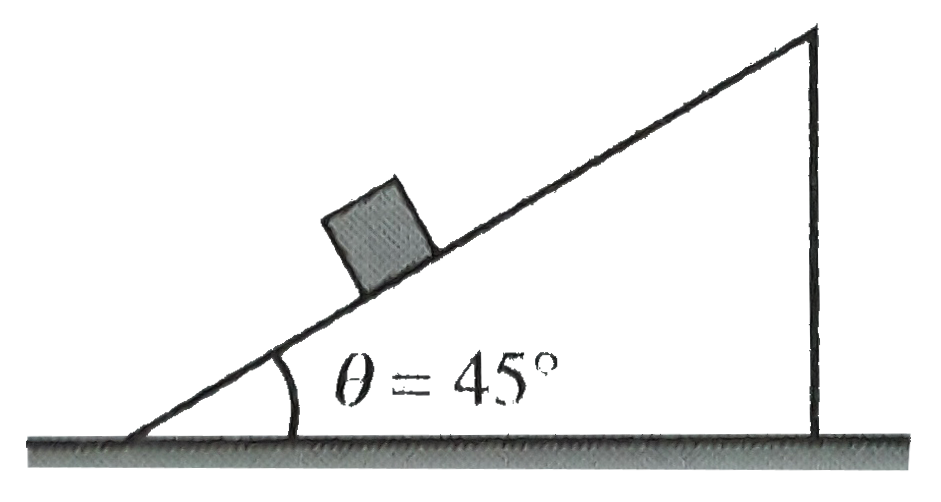A body of mass 2 kg is lying on a rough inclined plane of inclination 30º. Find the magnitude of force parallel to incline needed to make the block move (a)up the incline (b)down the incline. Coefficient of static friction = 0.2
13N,5N
13N,13N
13N,0N
5N,13N
The correct Answer is:C
To solve the problem step by step, we will analyze the forces acting on the body on the inclined plane and calculate the required force to move the block up and down the incline.
Given Data:
- Mass of the body (m) = 2 kg
- Inclination angle (θ) = 30°
- Coefficient of static friction (μ) = 0.2
- Acceleration due to gravity (g) = 10 m/s² (approx.)
Step 1: Calculate the weight of the body.
The weight (W) of the body can be calculated using the formula:
W=m⋅g
W=2kg⋅10m/s2=20N
Step 2: Resolve the weight into components.
The weight can be resolved into two components:
1. Perpendicular to the incline (Normal force, N)
2. Parallel to the incline (Force due to gravity along the incline)
The components are given by:
- Normal force (N):
N=W⋅cos(θ)=20N⋅cos(30°)
N=20N⋅√32=10√3N
- Force parallel to the incline (F_parallel):
Fparallel=W⋅sin(θ)=20N⋅sin(30°)
Fparallel=20N⋅12=10N
Step 3: Calculate the maximum static friction force.
The maximum static friction force (F_friction) can be calculated using:
Ffriction=μ⋅N
Ffriction=0.2⋅(10√3)
Ffriction=2√3N
Step 4: Calculate the force needed to move the block up the incline.
To move the block up the incline, the applied force (F_applied) must overcome both the gravitational force acting down the incline and the frictional force:
Fapplied=Fparallel+Ffriction
Fapplied=10N+2√3N
Calculating 2√3:
2√3≈3.46N
Thus,
Fapplied≈10N+3.46N≈13.46N
Step 5: Calculate the force needed to move the block down the incline.
To move the block down the incline, the applied force must overcome the frictional force acting upward and the component of the weight acting down the incline:
Fapplied=Ffriction−Fparallel
Since the block will naturally tend to slide down due to gravity, we can express:
Fapplied=Fparallel−Ffriction
Fapplied=10N−2√3N
Fapplied≈10N−3.46N≈6.54N
Final Answers:
- (a) The force needed to move the block up the incline is approximately 13.46 N.
- (b) The force needed to move the block down the incline is approximately 6.54 N.
- Mass of the body (m) = 2 kg
- Inclination angle (θ) = 30°
- Coefficient of static friction (μ) = 0.2
- Acceleration due to gravity (g) = 10 m/s² (approx.)
The weight (W) of the body can be calculated using the formula:
W=m⋅g
W=2kg⋅10m/s2=20N
The weight can be resolved into two components:
1. Perpendicular to the incline (Normal force, N)
2. Parallel to the incline (Force due to gravity along the incline)
- Normal force (N):
N=W⋅cos(θ)=20N⋅cos(30°)
N=20N⋅√32=10√3N
Fparallel=W⋅sin(θ)=20N⋅sin(30°)
Fparallel=20N⋅12=10N
The maximum static friction force (F_friction) can be calculated using:
Ffriction=μ⋅N
Ffriction=0.2⋅(10√3)
Ffriction=2√3N
To move the block up the incline, the applied force (F_applied) must overcome both the gravitational force acting down the incline and the frictional force:
Fapplied=Fparallel+Ffriction
Fapplied=10N+2√3N
2√3≈3.46N
Thus,
Fapplied≈10N+3.46N≈13.46N
To move the block down the incline, the applied force must overcome the frictional force acting upward and the component of the weight acting down the incline:
Fapplied=Ffriction−Fparallel
Since the block will naturally tend to slide down due to gravity, we can express:
Fapplied=Fparallel−Ffriction
Fapplied=10N−2√3N
Fapplied≈10N−3.46N≈6.54N
- (a) The force needed to move the block up the incline is approximately 13.46 N.
- (b) The force needed to move the block down the incline is approximately 6.54 N.
Topper's Solved these Questions
Similar Questions
A body of mass 2 kg is lyign on rough inclined plane of inclination 30 0 . Find the mgnitude of the force parallel to the incline needed to make tkheblock move a. up the incline b. down the incline. Coefficient of static friction =0.2
Repeat part a. of problem 6 if the push is applied horizontally and not parallel to the incline.
View SolutionA body of mass 2 kg is lyign on rough inclined plane of inclination 300. Find the mgnitude of the force parallel to the incline needed to make tkheblock move a. up the incline b. down the incline. Coefficient of static friction =0.2
View Solution
Knowledge Check
A body of mass 10kg is lying on a rough inclined plane of inclination 37∘ and μ=1/2 , the minimum force required to pull the body up the plane is
A80NB100NC120ND60NA block of mass 5 kg is placed on a rough inclined plane. The inclination of the plane is gradually increased till the block just begins to slide down. The inclination of the plane is than 3 in 5. The coefficient of friction between the block and the plane is (Take, g=10m/s2)
A35B34C45D23A body of mass m is kept on a rough fixed inclined plane of angle of inclination θ=30∘. It remains stationary. Then magnitude of force acting on the body by the inclined plane is equal to :
AmgBmgsinθCmgcosθDnone of these
A block of mass m=3kg slides on a rough inclined plane of cofficient of friction 0.2 Find the resultant force offered by the plane on the block

View SolutionA block of mass 10 kg is kept on a fixed rough (μ=0.8) inclined plane of angle of inclination 30∘. The frictional force acting on the block is

View SolutionA block of mass m moves with constant speed down the inclined plane of inclination θ. Find the coefficient of kinetic friction.

View SolutionWhen a body is lying on a rough inclined plane and does not move, the force of friction
View SolutionA body is projected up along a rough inclined plane of inclination 45∘ . The coefficient of friction is 0.5. Then the retardation of the block is
View Solution

